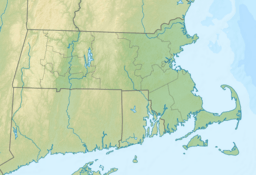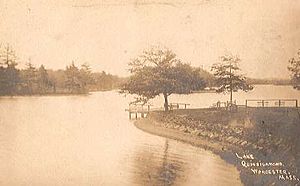Lake Quinsigamond facts for kids
Quick facts for kids Lake Quinsigamond |
|
|---|---|
| Location | Shrewsbury / Worcester, Worcester County, Massachusetts |
| Coordinates | 42°16′15″N 71°45′18″W / 42.27083°N 71.75500°W |
| Primary outflows | Quinsigamond River |
| Basin countries | United States |
| Max. length | 4 mi (6 km) |
| Surface area | 772 acres (312 ha) |
| Max. depth | 85 ft (26 m) |
| Surface elevation | 358 ft (109 m) |
| Islands | 8 (Drake Island) |
Lake Quinsigamond (also known as Long Pond) is a beautiful body of water. It sits between the city of Worcester and the town of Shrewsbury in Worcester County, Massachusetts, USA.
The lake is about 4 miles (6 km) long. It can be between 50 and 85 feet (15 and 26 m) deep. The surface area is around 772 acres (3.1 km²). Lake Quinsigamond has 8 islands. Most of these islands are owned by private citizens. Two islands are connected to the land by bridges. The biggest island, Drake Island, is still owned by the state. Water from the lake flows into the Quinsigamond River.
Contents
Crossing Lake Quinsigamond
The long, narrow shape of Lake Quinsigamond made it tricky to cross. Early settlers in the 1600s had to travel around the northern and southern ends of the lake. This was because they didn't have modern ways to build bridges.
At the start of the 1800s, a man named Isaiah Thomas planned a direct road. This road would connect Worcester to Boston. It eventually became Route 9. But first, they had to solve the problem of crossing the lake.
Early Bridge Attempts
The first bridge across the lake was built in 1806. It was a floating bridge made of logs. This bridge was not very stable. It would often sway when wagons pulled by horses crossed it. Strong waves broke the floating bridge apart in 1806. It was rebuilt in 1807 as a temporary solution.
The second bridge was an early suspension bridge. It was finished in early 1817. Nine wooden piers were built into the lakebed to hold up the bridge. The bridge was covered with gravel planks. However, the lakebed was unstable. The piers settled at different levels. This caused gaps to appear in the road. On September 19, 1817, the piers and the bridge broke apart and fell into the water. After this collapse, a second floating bridge was built. This one lasted until 1861.
The Causeway and Modern Bridges
The first stable bridge over Lake Quinsigamond was an earthen causeway. It was the fourth attempt overall. This causeway was finished in 1863. It was made from a mix of rock, gravel, and dirt. This was the first bridge that did not sway under heavy loads.
The causeway split the lake in half. This made it harder for steamboats to travel across the lake. People at the time thought the causeway looked ugly. Despite these issues, it lasted until the early 1900s. Around 1900, the causeway was made wider. It added tracks for trolleys. These trolleys connected downtown Worcester to fun places by the lake.
A new, modern bridge replaced the old causeway on July 31, 1919. It was made of stone, cement, and steel. This bridge had two lanes. In 1973, renovations made the bridge wider. It became a four-lane road. At the north end of the lake, another bridge was built. This bridge carries Interstate 290.
The newest bridge is the Kenneth F. Burns Memorial Bridge. It opened on November 1, 2015. This bridge carries Route 9 over Lake Quinsigamond. It is a steel arch bridge with two separate parts. One part is for eastbound traffic, and the other is for westbound traffic. Each part is 870 feet long. They are supported by concrete structures. Both parts have three traffic lanes, a bike lane, and a walkway for people. There are also spots to stop and enjoy views of the lake.
Fun Things to Do at the Lake
Past Attractions
Most of the fun places by the lake were built on the southern shores. This happened after the causeway was built in 1863. The causeway divided the lake for people traveling by water. This included steamboat rides and competitive rowers.
Lincoln Park was a family amusement park. It opened on the Worcester side of the lake in 1894. Steamboat rides had started twenty years earlier from the same spot. Horace H. Bigelow, a local businessman, opened another amusement park. It was called White City. It opened on the Shrewsbury side in 1905.
Both parks became famous for their unique rides. Lincoln Park had the 'Dummy Railroad.' This was a passenger train that ran between Union Station in Worcester and the park. White City was known for its artificial lake and the 'Shoot-the-Chutes' water ride. It also had many other water attractions.
By the 1940s, fewer people visited both parks. This was because other areas along the lake were being developed. White City, which once had '50,000 Electric Lights,' closed on Labor Day, 1960. Lincoln Park closed in 1961. The White City property was sold in November of that year. Sadly, both parks lost buildings to suspicious fires in their final years.
Current Attractions
Albert Shore bought the White City property. He turned the land into a shopping center and movie theater. This happened soon after the amusement park closed. The shopping center is still called White City today. The movie theater, White City Cinemas, has closed recently. An apartment complex for older adults now stands where Lincoln Park used to be.
Quinsigamond State Park
Quinsigamond State Park is located on the Worcester side of the lake. You can find it both north and south of Route 9. It's a great place to enjoy the outdoors.
Rowing on the Lake
Competitive rowing teams first came to Lake Quinsigamond in 1857. Rowers found the lake perfect for crew regattas (boat races). Soon, people started boating clubs on the lake's shores. The first one was the Quinsigamond Boating Club.
More boating clubs and races followed. Many colleges, both local and from other areas, held regattas on the lake. These included the New England Rowing Championships and the ECAC National Invitational Championship. Other big races like the Eastern Sprints, Big East Championship, and Patriot League Championship also took place here.
The NEIRA championship regatta has been held on the lake since the 1950s. Now, over 40 schools compete in different boat divisions. These include 8+, 4+, and 1X boats. Starting in 1895, local high schools also held crew races on the lake. In 1952, the lake was even chosen to host the National Olympic rowing trials. The Quinsigamond Rowing Association hosted the US Rowing Masters National Championship in 2005, 2012, and 2016.
- Perna, Michael P. Jr. (1997). Remembering Lake Quinsigamond: From Steamboats to White City. Worcester: Chandler House Press. ISBN: 1-886284-02-4
- Southwick, Albert B. (1994). Once-Told Tales of Worcester County. Worcester: DATABOOKS. ISBN: 0-9636277-5-9




